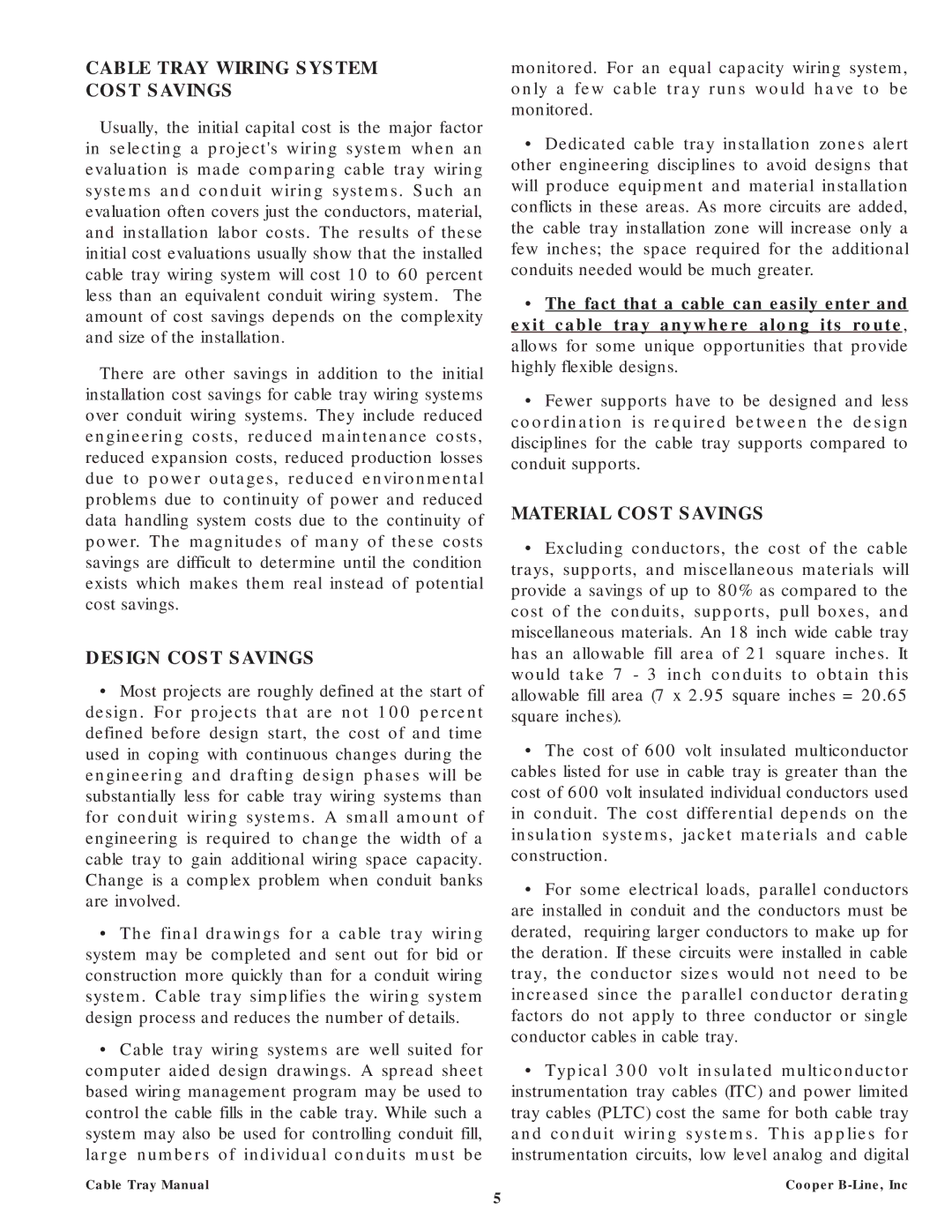CABLE TRAY WIRING SYSTEM
COST SAVINGS
Usually, the initial capital cost is the major factor in selecting a project's wiring system when an evaluation is made comparing cable tray wiring systems and conduit wiring systems. Such an evaluation often covers just the conductors, material, and installation labor costs. The results of these initial cost evaluations usually show that the installed cable tray wiring system will cost 10 to 60 percent less than an equivalent conduit wiring system. The amount of cost savings depends on the complexity and size of the installation.
There are other savings in addition to the initial installation cost savings for cable tray wiring systems over conduit wiring systems. They include reduced engineering costs, reduced maintenance costs, reduced expansion costs, reduced production losses due to power outages, reduced environmental problems due to continuity of power and reduced data handling system costs due to the continuity of power. The magnitudes of many of these costs savings are difficult to determine until the condition exists which makes them real instead of potential cost savings.
DESIGN COST SAVINGS
•Most projects are roughly defined at the start of design. For projects that are not 100 percent defined before design start, the cost of and time used in coping with continuous changes during the engineering and drafting design phases will be substantially less for cable tray wiring systems than for conduit wiring systems. A small amount of engineering is required to change the width of a cable tray to gain additional wiring space capacity. Change is a complex problem when conduit banks are involved.
•The final drawings for a cable tray wiring system may be completed and sent out for bid or construction more quickly than for a conduit wiring system. Cable tray simplifies the wiring system design process and reduces the number of details.
•Cable tray wiring systems are well suited for computer aided design drawings. A spread sheet based wiring management program may be used to control the cable fills in the cable tray. While such a system may also be used for controlling conduit fill, large numbers of individual conduits must be
Cable Tray Manual
monitored. For an equal capacity wiring system, only a few cable tray runs would have to be monitored.
•Dedicated cable tray installation zones alert other engineering disciplines to avoid designs that will produce equipment and material installation conflicts in these areas. As more circuits are added, the cable tray installation zone will increase only a few inches; the space required for the additional conduits needed would be much greater.
•The fact that a cable can easily enter and exit cable tray anywhere along its route, allows for some unique opportunities that provide highly flexible designs.
•Fewer supports have to be designed and less coordination is required between the design disciplines for the cable tray supports compared to conduit supports.
MATERIAL COST SAVINGS
•Excluding conductors, the cost of the cable trays, supports, and miscellaneous materials will provide a savings of up to 80% as compared to the cost of the conduits, supports, pull boxes, and miscellaneous materials. An 18 inch wide cable tray has an allowable fill area of 21 square inches. It would take 7 - 3 inch conduits to obtain this allowable fill area (7 x 2.95 square inches = 20.65 square inches).
•The cost of 600 volt insulated multiconductor cables listed for use in cable tray is greater than the cost of 600 volt insulated individual conductors used in conduit. The cost differential depends on the insulation systems, jacket materials and cable construction.
•For some electrical loads, parallel conductors are installed in conduit and the conductors must be derated, requiring larger conductors to make up for the deration. If these circuits were installed in cable tray, the conductor sizes would not need to be increased since the parallel conductor derating factors do not apply to three conductor or single conductor cables in cable tray.
•Typical 300 volt insulated multiconductor instrumentation tray cables (ITC) and power limited tray cables (PLTC) cost the same for both cable tray and conduit wiring systems. This applies for instrumentation circuits, low level analog and digital
Cooper
5
